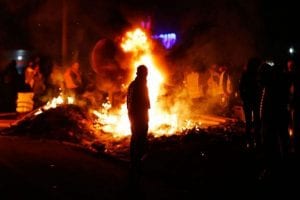The flyer above is designed to advertise an 80s themed party at “The Haunt” in Brighton. This short essay will examine and explain its key features as practical examples of the language used in advertising.
Advertisements are usually constructed using signs, representing things or ideas, and written texts. Any message, any meaning, can only be communicated through the sign system that comprehends signifier, the actual look of the sign, and signified, the concepts and ideas understood through that sign (O’Shaughnessy, Stadler and Casey, 2016). In our mediated world, advertisements are decidedly visual expressions of culture and society (Page, 2006). Due to the differences within everyone’s personal experience, advertisements can be “polysemic” and carry different meanings depending on the reader. Therefore, the meanings of signs and texts in the language of advertising are often constructed relying on the general knowledge of the society, a process called “intertextuality”.
O’Shaughnessy, Stadler and Casey (2016) explain how intertextuality is defined as the act of knowingly borrowing and referring to other texts, very often from popular culture, in order to interpret another text. In the case of the flyer, the text I am referring to, to advertise the party, is a line from the lyrics of the famous song “Footloose” from the homonym 1984 film. The movie has become so popular that its songs are considered the hymns of the 80s and the disco culture of those years. Thus, using the line “Kick off the Sunday shoes” has a strong connotational impact on the reader, who is brought to associate the advertised party with the remembrance of the movie’s environment and style.
“Association” is, indeed, one of the techniques that Prelipceanu (2013) consider as very powerful in what she defines as “the language of persuasion”. According to the author, the use of os association to connect a product or a service with something already liked by the target customer can have a very strong emotional transfer with feelings such as nostalgia.
The theme of the movie on the flyer is reinforced by the use of bright neon colours on a background that resembles a disco ball, which gives an idea of what the party would be like. In a smaller size, the information about the date and time and the logo of the club act as “anchorage”, a caption that limits polysemy by articulating the preferred meaning of the text (Barthes, 1977). Specifically for the flyer, the logo specifies that it is a party that is being advertised and not something else.
It could be argued, in conclusion, that the features described above are persuasive and could induce customers to act unconsciously. That would be a valid argument since very often consumers value products not as simple items, but as tokens of happiness, love and better lives (Prelipceanu, 2013). However, it is up to every person to question everything they see and it is up to every advertiser to make responsible choices in what messages it is right to transmit.
References
- Barthes, R. & Heath, S. (1977) Image, music, text: essays. London: Fontana Press.
- O’Shaughnessy, M., Stadler, J. & Casey, S. (2016) Media & society (6th edn.). Australia: Oxford University Press.
- Page, J.T. (2006) “Myth and Photography in Advertising: A Semiotic Analysis”, Visual Communication Quarterly, vol. 13, no. 2, pp. 90-109.
- PRELIPCEANU, C. (2013) “ADVERTISING AND LANGUAGE MANIPULATION”, Diversitate si Identitate Culturala in Europa, vol. 10/2, no. 2013, pp. 247-254.


